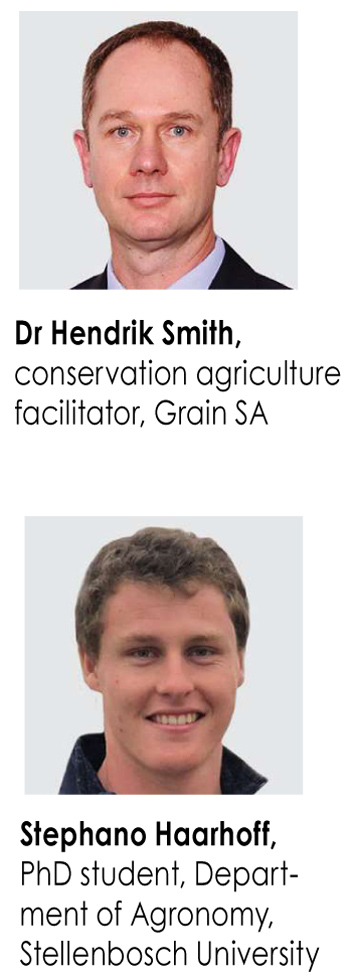 Since converting from conventional tillage to no-tillage, the functionality of cropping systems across Argentina has changed
Since converting from conventional tillage to no-tillage, the functionality of cropping systems across Argentina has changed
considerably. The newly introduced agronomic management practices have unlocked unused potential of the soil-crop system while simultaneously enhancing sustainable crop production.
In turn, cropping systems have become more stable over long-term periods and have enabled producers to plan each season according to prevailing climate conditions and on-farm needs.
Cropping systems
Soybean, maize and wheat are the main crops produced across the Argentine Pampas, accounting for 78% of the 32 million ha used for crop production. Depending on climate conditions, producers plant a single (full-season) soybean or maize crop annually with the double-cropping system implemented where soil water levels are adequate (Table 1).
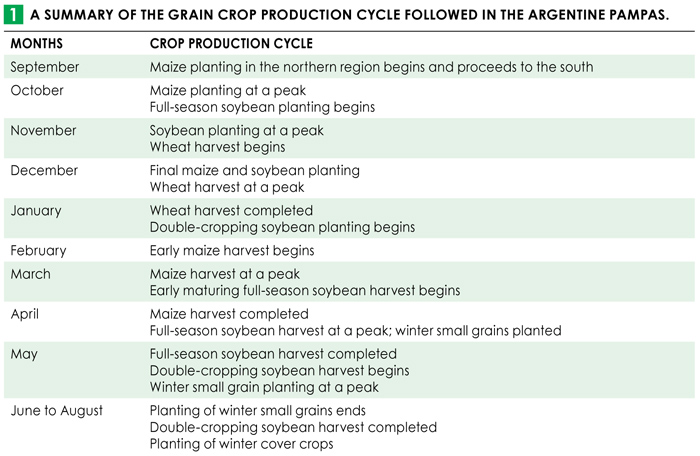 In the double-cropping system, wheat is drilled into crop residues directly after the summer crop harvest is completed. The crop residues protect the soil against strong winds occurring throughout the winter season and decrease evaporation losses from the soil surface.
In the double-cropping system, wheat is drilled into crop residues directly after the summer crop harvest is completed. The crop residues protect the soil against strong winds occurring throughout the winter season and decrease evaporation losses from the soil surface.
Seasonal rainfall variability makes crop production in the Argentine Pampas challenging, ranging from droughts to extreme wet weather. In some years, high rainfall continues until late in May. This causes the germination of soybean seeds in the pods prior to harvest, resulting in severe crop losses. More recently, producers have been forced to establish soybean and maize later in the season (December) due to the delayed arrival of rainfall.
This has resulted in a prolonged fallow period prior to planting and subsequently more herbicide applications. To avoid this, cover crops are established after harvest, introducing a green fallow period to protect and improve the soil and outcompete weeds. However, low soil water levels are the main constraint on this practice, especially in the semi-arid region of Argentina. Ongoing on-farm and research trials are currently investigating potential management practices to overcome this challenge.
Weed management
In the former conventional tillage systems, weed control was one of the major challenges producers encountered year-round. As soils were frequently disturbed, weed seeds were constantly brought to the soil surface initiating germination due to favourable soil temperatures. In addition, weeds established during fallow periods exhausted soil water and nutrients. This highlighted the need for alternative weed control approaches to eliminate the inefficient facets of the cropping systems.
The adoption of no-tillage provided the tools for new approaches. Minimal soil disturbance and herbicides were initially an effective weed control strategy. However, new challenges emerged as time passed. High volumes of glyphosate were used annually with Roundup Ready soybean and maize, resulting in resistant weeds. Again, long-term sustainable approaches were needed.
When converting from a conventional tillage to a no-tillage system, the spectrum and occurrence of weed species change. To combat this, Argentine producers are aiming to follow approaches which are sustainable over longer periods:
- Soil mulch cover is a priority (primarily for weed control and soil protection). A great amount of sunlight is intercepted by the mulch cover resulting in low soil temperatures. In this way, seed germination is supressed and weed establishment is largely side-stepped. The success of this cooling effect lies in the fact that the minimum soil temperature stays unaffected, but that the maximum temperature the soil will reach is reduced, thus preventing seed germination. To achieve this, a minimum mulch cover of 6 t/ha dry matter is needed. There is a strong belief in Argentina that if you maintain 80% of shadow provided by a mulch cover, up to 80% of weed suppression is possible.
- Growing crops on a continuous basis provides additional weed suppression methods, as leaf canopies influence the plant-soil system alternatively. Although this practice does increase the competition for soil water and nutrients, the crop leaf canopy intercepts incoming sunlight with only scattered and low energy sunlight reaching the soil surface. Again, lower soil temperatures are expected, but not to such an extent as caused by a mulch cover. Suboptimal soil temperatures lead to very low germination and seedling growth rates and ultimately result in seedling failure and reduced weed establishment.
- Finally, crop rotation is implemented as it provides several tools producers can use to their advantage to control weeds. The difference in root systems, leaf canopy structure, nutritional differences and growth cycles between different crops (e.g. sunflowers, soybean, maize and cover crops) provide a new set of challenging growing conditions for weeds each year. Also, interannual change in type of herbicide usage may prolong the development of herbicide resistance in weeds.
Cover crops
In the humid Pampas, the wet season peaks during March and provides the option to establish cover crops after the soybean or maize harvest. Current research is investigating several cover crop species to increase mulch cover build-up, promote crop diversification and the provision of cattle forage during the dry season.
The choice of winter cover crop species is important due to the variation in growth cycles and resource demands. For example, vetch may provide nitrogen to the cropping system (nitrogen fixator), but its initial growth rate is very low and consequently controls autumn weeds poorly.
Grass species, such as triticale and oats, compete strongly with weeds by maintaining high growth rates. Weeds may be present in these grassy type cover crop stands (without any herbicide applications), but their growth is poor and they have little effect. It is important to acknowledge that grass species have a high water demand and may exhaust available soil water.
A 23-year long-term trial has investigated the effects of integrating a cover crop (triticale) in a maize/soybean cropping system in the Argentine Pampas. In the grain-only system (without a cover crop), soybean yields were approximately 9% lower than the same rotational system with a cover crop included over 23 years (Graph 1).
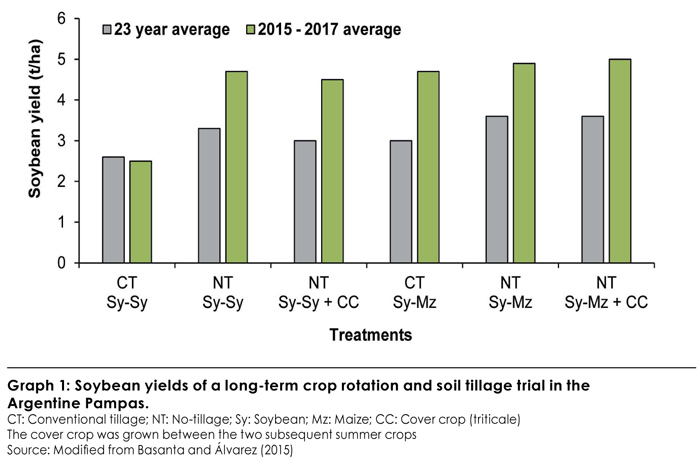 Also, the soybean yield under no-tillage and in rotation with maize was approximately 1 t/ha higher compared to monoculture soybean under conventional tillage, highlighting the impact of agronomic management factors on crop yields. On average, the soybean-maize plus cover crop system yielded only 18% lower compared to a no-cover crop system over 23 years (Graph 2). These lower maize yields were attributed to lower soil nitrogen levels following the cover crop.
Also, the soybean yield under no-tillage and in rotation with maize was approximately 1 t/ha higher compared to monoculture soybean under conventional tillage, highlighting the impact of agronomic management factors on crop yields. On average, the soybean-maize plus cover crop system yielded only 18% lower compared to a no-cover crop system over 23 years (Graph 2). These lower maize yields were attributed to lower soil nitrogen levels following the cover crop.
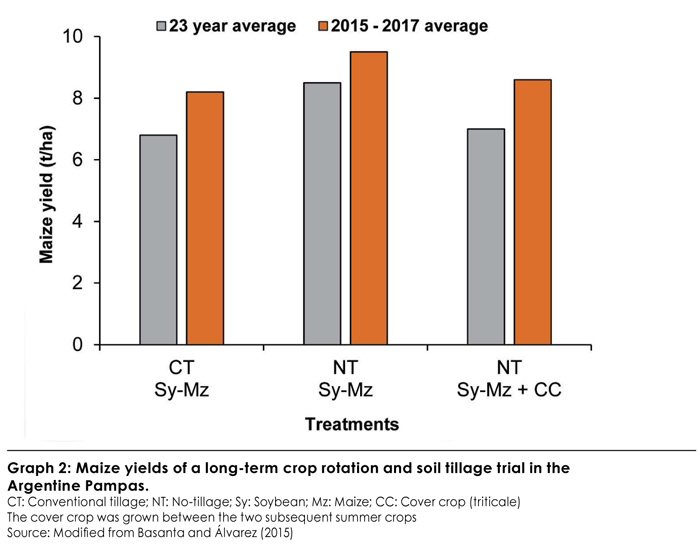 It is important to acknowledge the contribution of a cover crop to the functioning of the cropping system. Instead of a fallow period with very low soil cover, the growing cover crop provide valuable grazing material, through which value is added to the livestock. The live roots during the winter season provide carbon sources for soil microbes, which may enhance organic matter build-up over several years.
It is important to acknowledge the contribution of a cover crop to the functioning of the cropping system. Instead of a fallow period with very low soil cover, the growing cover crop provide valuable grazing material, through which value is added to the livestock. The live roots during the winter season provide carbon sources for soil microbes, which may enhance organic matter build-up over several years.
The soil surface is protected from direct sunlight and wind erosion, while good cover is present at the offset of the rainy season and planting season. In regions where mulch cover build-up is a challenge, cover crops can be used as a tool to enhance this critical factor, as illustrated in Graph 3. The average contribution in biomass production (in addition to crop residues of the previous summer crop) by triticale was 3,1 t/ha and 2,3 t/ha in the soybean-maize and soybean-soybean crop rotation, respectively.
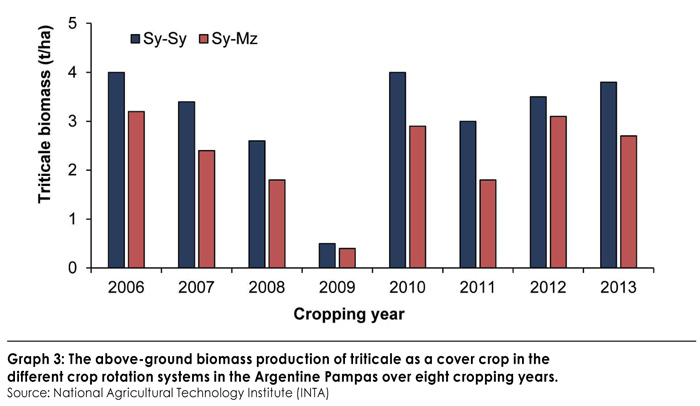 Integrated pest management
Integrated pest management
Integrated pest management is a control method of combining several agronomic management practices to control pests over the long term. Information regarding the growth stages of pests, biological cycles of crops and the relationship between pests and crops are critical in making management decisions.
In the Argentine Pampas, main pests include fall army worm (Spodoptera frugiperda), sugarcane borer (Diatraea saccharalis), stem borer (Scirpophaga incertulas) and cutworms.
Tools for integrated pest management in the Argentine Pampas include:
- Chemical control;
- crop rotation;
- tolerant hybrids; and
- planting dates.
By combining these management tools and applying them in accordance with pest growth cycles, crop losses may be lowered. As an example, cutworms’ life cycle finishes close to the time of maize planting in the Argentine Pampas. Therefore, producers extend maize planting dates in combination with chemical control to lower potential damage to maize seedlings.
Final remarks
The challenges faced within a cropping system need to be addressed by using a unique set of management tools available to the producer. By investigating climate conditions and the soil water and fertility status, producers can gather information to consider possible management strategies.
Using this as a point of departure, soils and plants can be managed accordingly, using multi-ecosystem services as a way to produce crops in a profitable and sustainable manner in the long run.
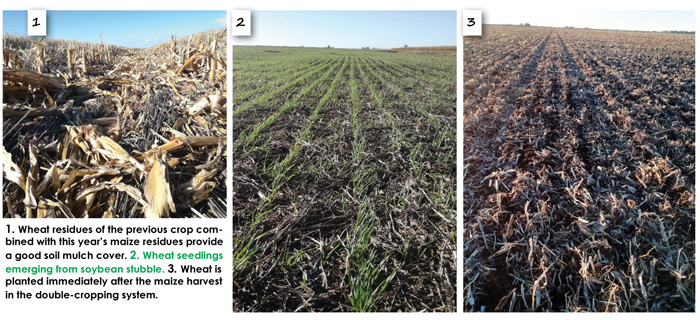 Reference
Reference
1. Basanta, M., and Alvarez, C. (2015). Sustainable management of agricultural systems in the central region of Córdoba: a long-term experience at INTA EEA Manfredi. ESTUARY. Agricultural Research Journal, 41 (2), 215 – 222.

















